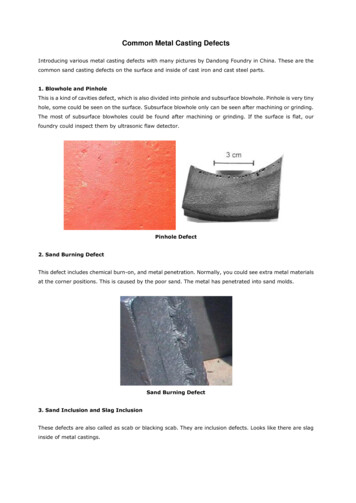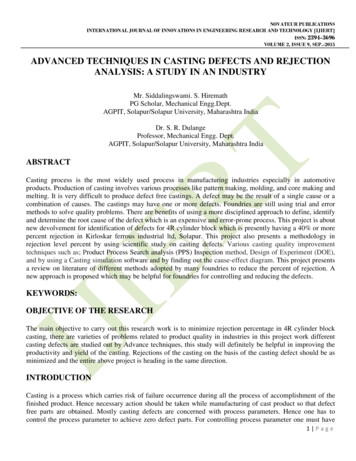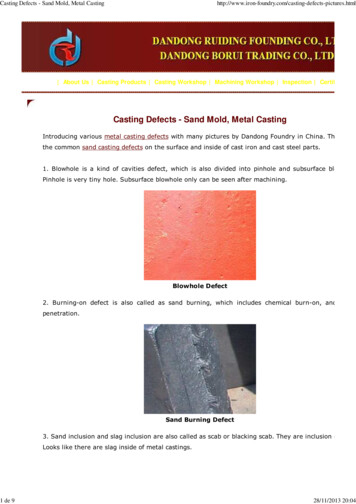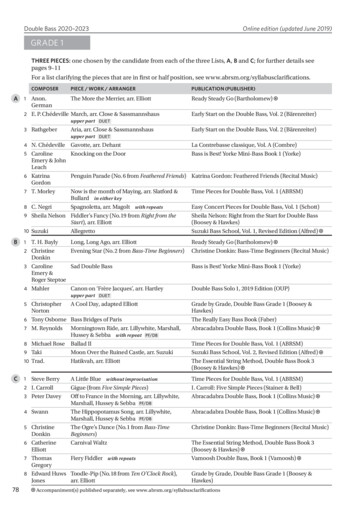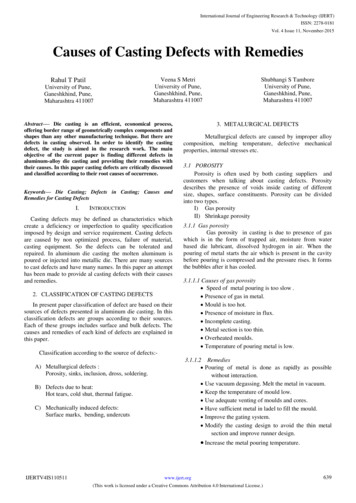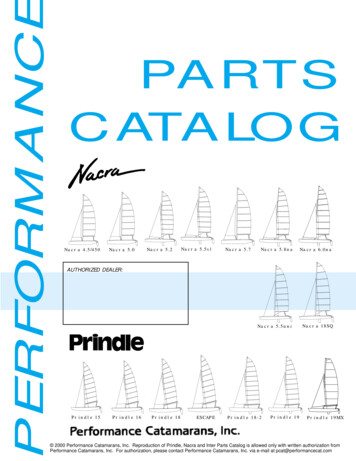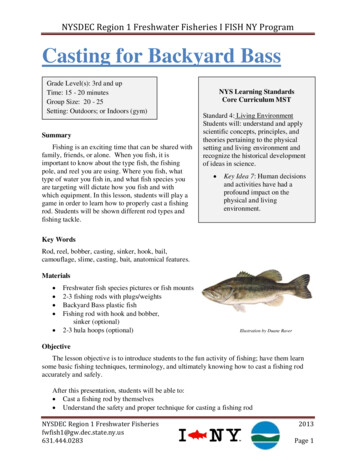
Transcription
NYSDEC Region 1 Freshwater Fisheries I FISH NY ProgramCasting for Backyard BassGrade Level(s): 3rd and upTime: 15 - 20 minutesGroup Size: 20 - 25Setting: Outdoors; or Indoors (gym)SummaryFishing is an exciting time that can be shared withfamily, friends, or alone. When you fish, it isimportant to know about the type fish, the fishingpole, and reel you are using. Where you fish, whattype of water you fish in, and what fish species youare targeting will dictate how you fish and withwhich equipment. In this lesson, students will play agame in order to learn how to properly cast a fishingrod. Students will be shown different rod types andfishing tackle.NYS Learning StandardsCore Curriculum MSTStandard 4: Living EnvironmentStudents will: understand and applyscientific concepts, principles, andtheories pertaining to the physicalsetting and living environment andrecognize the historical developmentof ideas in science. Key Idea 7: Human decisionsand activities have had aprofound impact on thephysical and livingenvironment.Key WordsRod, reel, bobber, casting, sinker, hook, bail,camouflage, slime, casting, bait, anatomical features.Materials Freshwater fish species pictures or fish mounts2-3 fishing rods with plugs/weightsBackyard Bass plastic fishFishing rod with hook and bobber,sinker (optional)2-3 hula hoops (optional)Illustration by Duane RaverObjectiveThe lesson objective is to introduce students to the fun activity of fishing; have them learnsome basic fishing techniques, terminology, and ultimately knowing how to cast a fishing rodaccurately and safely.After this presentation, students will be able to: Cast a fishing rod by themselves Understand the safety and proper technique for casting a fishing rodNYSDEC Region 1 Freshwater 3Page 1
NYSDEC Region 1 Freshwater Fisheries I FISH NY ProgramUnderstand some basic differences & techniques when fishing saltwater or freshwater.Vocabulary .Bait – artificial or live animals such as worms, flies, or fish can be used toattract the targeted species.Bobber – the float attached to the line to help indicate if a fish is hooked.Camouflage – The ability to blend in with the background or habitat.Casting – the act of rod movement and reel-release in order to place hook &bait in desired spot.Hook – barbed metal bent backwards, baited with live or artificial bait.Sizes vary according to desired fish to catch.Reel – the spool of line attached to the rod; many varieties.Rod – the fishing pole; which can be designed for saltwater or freshwater,gamefish or small panfish, ocean or stream.Sinker – a weight used to take bait & hook toward bottom of water body.Tackle – the gear and equipment used to go fishing.Operculum(gill cover)Gills (underoperculum)Pectoral FinDorsal FinLateral LineNaresTail/Caudal FinMouthPelvic FinNYSDEC Region 1 Freshwater l Fin2013Page 2
NYSDEC Region 1 Freshwater Fisheries I FISH NY ProgramBackgroundTypes of Fishing ReelsThere are four types of fishing reels: spincasting, spinning, baitcasting, and conventional. (Afifth type of reel known as a fly-fishing reel is not addressed in this lesson). Baitcasting andconventional are sophisticated reels, and are not often used with beginners. For this lesson, wewill focus on spincasting and spinning reels.SpincastingIn spincasting, the reel is enclosed in housing.Because this type of reel reduces the number ofline tangles, it is best suited for beginners fishingin freshwater. The reel sits on the top of the rodfacing you with the guides facing up at you aswell. To release the line, you press and release thepush button located at the back of the reel (closestto you). To wind the line back in, you turn thehandle away from you.Spinning ReelsSpinning reels have no housings and are open.They are used in both fresh and saltwater. Thespinning reel should be on the downside of the rod,facing the ground as should the guides. The line isreleased by flipping up the bail (thin silver U-shapedbar) on the front of the reel. You must pinch the lineagainst the rod handle with your finger before flippingup the bail. Line is wound-up by turning the reelhandle, again away from you. Right-handed anglerswill reel in using the handle on the left side. Spinning reels are the most common type of reel,and used by all skill levels, from strong beginners to advanced anglers.TackleWhen fishing with beginners, fishing with bait is ideal. Bobbers, sinkers, and hooks are themain pieces of fishing tackle needed.Bobbers and FloatsBobbers, or floats, are designed to keep the bait suspended above the bottom, or away fromweeds and other obstructions. You can change the length of fishing line in the water by movingthe bobber up or down along the line. Bobbers indicate when a fish is striking. If the bobber ismoving up and down (bobbing) in the water, it means that you have a bite.NYSDEC Region 1 Freshwater 3Page 3
NYSDEC Region 1 Freshwater Fisheries I FISH NY ProgramSinkersThe main purpose of sinkers is to add weight to the line. Sinkersare used for bottom-fishing, or to get your bait further out into thewater. Small sinkers used to be mad of lead, which is toxic toanimals if swallowed, for example birds. Today, small sinkers arenow made of non-toxic materials so as not to harm wildlife if eaten.Large sinkers are still made of lead, but they are large enough thatwildlife are unlikely to eat them.HooksHooks are extremely important when fishing. Circle hooks areshaped like “C’s” with tips turned perpendicularly back towards theshank. They are designed to only hook on exposed surfaces such asa fish’s mouth. If a fish swallows your circle hook, as you reel in, the hook will pull out (versus aregular hook, which could be caught in the fish’s gut). Tamping down the barb (pinching it withpliers) will also help to safely and quickly release a fish.CastingIt is important to be aware of your surroundings when casting. Before casting, survey thearea to see if there are any plants, trees or shrubs that your line can snag your line. It is alsoimportant to be aware of people nearby, and to respect their space.Using a Spincasting ReelWhen using a spincasting reel, pushand hold the button all the way down.Look behind you for obstructions,people, and anything that could snagyour line. To cast, slowly bring yourhand up just about your shoulder. Thepole should be pointing back over yourshoulder so it is between vertical andhorizontal to the ground. As the pole is smoothly brought forward, release the button as the rodpasses the vertical position. Be sure to not bring the tip of the fishing pole in contact with theground on your follow-through. After the bobber and hook are in the water, rotate the handleone full circle to lock the line.Using a Spinning ReelWhen using a spinning reel, pinch the line against the rod with 1 or 2 fingers and open the“U-shaped” bail. Look behind you. Bring the pole back over your shoulder as with a spincastingreel. As you bring the pole forward, release your finger(s) as the rod passes the vertical. Be sureto not bring the tip of the fishing pole in contact with the ground. After the bobber and hook arein the water, rotate the handle one full circle to lock the line; this should automatically close thebail. (Tip: If bail does not close automatically, close or flip it manually.)NYSDEC Region 1 Freshwater 3Page 4
NYSDEC Region 1 Freshwater Fisheries I FISH NY ProgramCasting TipWith either type of reel, it is not necessary tocontinually “cast and reel” numerous times, as the fish needto be able to smell and see your bait before they bite. Besure to reel in any slack in the line, getting rid of any “curlycues”. Remember fishing is about patience, so sit back,relax, and enjoy!Illustration by Duane RaverMain ActivitySet up Casting Field1. Set up two casting fields with equal number of plastic Backyard Bass.a. Pick an open area.b. Be wary of trees or other objects participants can snag.2. Use hula-hoops as markers for participants to stand in while casting (optional).Fish Identification and Overview1. The instructor will go over a few local fish species using fish mounts or laminatedphotos. As each fish species is discussed, different external anatomical features and thefunction of these features will be introduced.Casting to Backyard Bass1. Introduce the proper use of a fishing rod. For example, while using a spincasting rod,demonstrate the following:a. Thumb on the button – sinker & “hook” don’t moveb. Take thumb off the button – sinker and hook are released and move freelyc. One turn of the handle locks the fishing lined. Don’t reel in all the way; so the sinker doesn’t get stuck in the top guide2. Explain casting to the Backyard Bass.a. Use 2-3 poles to cast into fishing areab. Demonstrate how to stand and cast with fishing rodi. Press and hold buttonii. Look behind youiii. Bring rod back to just past vertical positioniv. Cast; take finger off of button as rod is moving forwardv. Turn rod handle to lock line3. Debrief casting; review steps.If proceeding to fishing on site:a. Introduce rod safety with real hook and bobber.NYSDEC Region 1 Freshwater 3Page 5
NYSDEC Region 1 Freshwater Fisheries I FISH NY Programb. If using a spinning reel, hold the rod with one hand and a 2-finger pinch on leaderline with the other hand.c. Always walk with rod in one hand and line in the other; for example when:i. Need new baitii. Need new rodiii. Finished fishingiv. Moving fishing spotsd. No running when carrying fishing rod.e. During the game, cast and retrieve; when fishing with bobber set up, cast and waitfor fish to bite.i. Will know by bobber going under waterii. One can hold line in fingers as another way to “know” that fish is bitingClosing1. Reminders:a. Proper way to castb. Safety techniques for walking with a fishing pole2. Invite questions.Wrap UpReviewRemind students of the proper way to cast a fishing rod and the safety techniques for walkingwith a fishing poleStudents should be able to: Identify 1-3 species of fish specific to fishing area Demonstrate how to safely and properly cast a fishing rod Identify and use the proper terminology for fishing tackle.Questions for DiscussionQ: How would you define a predator?A: A fish (animal) that pursues another animal to eat it for foodQ: How would you define a prey?A: A fish (animal) that is being pursued as food for another animalQ: What are some characteristics of prey species that help them escape from predators?A: Schooling, fast moving, spiny dorsal fin, camouflageQ: What are some characteristics of predator species that help them catch prey?A: Camouflage, fast moving, sharp teeth, lying in waitNYSDEC Region 1 Freshwater 3Page 6
NYSDEC Region 1 Freshwater Fisheries I FISH NY ProgramQ: What does a bluefish eat?A: Smaller fish such as, herring, anchovies, shrimp, croakers, krill, crabs, squid, andmarine worms.Q: What is structure and how do fish use it to escape predators?A: Structure is a place to hide and find protection, such as reefs, pilings, logs, grasses.Small fish may find a hole or thick grass to nestle in, or go under a logQ: Name a prey species that you might catch today (site specific)A: examples may be small sunfish or small seabassQ: Name a predator species that you might catch today (site specific)A: examples may be large flounder or large pickerelWeb Resources“Getting Started: A Beginner’s Guide to Freshwater Fishing”. New York State Department ofEnvironmental Conservation publication. Contact your local DEC Regional OfficeNew York State Department of Environmental Conservation fishing l - information and literature for purchasing licenses,fishing regulations, places to fish, fish stocking sites, and fishery reports.http://www.dec.ny.gov/outdoor/44809.html - an excellent “how to” and “where to” fish guide forbeginners and intermediate fishermen.NYSDEC Region 1 Freshwater 3Page 7
Backyard Bass plastic fish Fishing rod with hook and bobber, sinker (optional) 2-3 hula hoops (optional) Objective . The lesson objective is to introduce students to the fun activity of fishing; have them learn some basic fishing techniques, terminology, and ultimately knowing how to cast a fishing rod accurately and safely.

